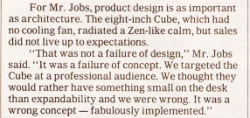Yeah, just in the AE environment, Particular, Cineware, Element 3D and the myriad of plugins use different technologies for acceleration. Each task relies on something different and often the solution I choose is based on the speed it will render, not how good it can look.
My current project is a high-profile doozie, and ultimately I'm torn between a CUDA-based Octane Render pipeline that is fast, but only implements a single machine or a traditional Cinema 4D render that isn't as fast but allows me to network render my z820 with my MP. And plenty of pitfalls along the way.
Ugh.
not that this solves you're current dilemma but have you checked out Thea and its new presto engine?
it's currently cuda only but the main dev has said it's written with openCL in mind (I'm going to butcher what he said if I try to paraphrase it.. on a phone right now so it's hard to get links etc.. I'll post later tonight)
anyway, I can pretty much guarantee any cuda based OSX apps will definitely become openCL in the near future.. or maybe drop OSX altogether.. but what I don't see happening is devs continuing to developed cuda apps for mac.


